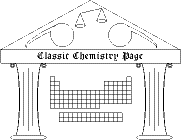Harcourt kinetics
Augustus Vernon Harcourt was an early investigator of the rates of chemical reactions, that is of chemical kinetics, including the temperature-dependence of reaction rates. This exercise, however, deals with the dependence of reaction rates on concentration for the reaction
H2O2 + 2 HI -- > 2 H2O + I2 .
1) In one experiment, Harcourt recorded the times at which the H2O2 concentration decreased by one unit. (Just what the units were is not specified.) Concentration/time data are presented below.
| conc. (H2O2) | time (min)
|
| 20.95 | 0.00
|
| 19.95 | 4.57
|
| 18.95 | 9.37
|
| 17.95 | 14.50
|
| 16.95 | 19.87
|
| 15.95 | 25.57
|
| 14.95 | 31.68
|
| 13.95 | 38.20
|
| 12.95 | 45.23
|
| 11.95 | 52.82
|
| 10.95 | 61.12
|
| 9.95 | 70.15
|
| 8.95 | 80.08
|
| 7.95 | 91.27
|
| 6.95 | 103.88
|
| 5.95 | 118.50
|
| 4.95 | 135.85
|
| 3.95 | 157.00
|
| 2.95 | 181.53
|
| 1.95 | 223.45
|
| 0.95 | 291.18
|
(Download a spreadsheet file containing Harcourt's data by clicking here.)
Determine the reaction order with respect to H2O2 and find an equation for the concentration of H2O2 (c) as a function of time (t) for this run. Try plotting c vs. t, ln c vs. t, and 1/c vs. t (plots that should yield straight lines if the reaction is zero-, first-, or second-order in H2O2).[1] From the best-fit equation of the appropriate linear plot, solve for c as a function of t.
2) Harcourt determined the reaction order with respect to iodide by the method we now call "initial rates." He measured the initial rate of reaction (actually the fraction of H2O2 consumed in a fixed time) for a variety of iodide concentrations. The data are shown below (in arbitrary units).
| I- conc. | initial rate
|
| 2 | 0.0302
|
| 3 | 0.0453
|
| 4 | 0.0602
|
| 5 | 0.0756
|
| 6 | 0.0905
|
(Download a spreadsheet file containing Harcourt's data by clicking here.)
Determine the reaction order with respect to iodide.
Reference
A. Vernon Harcourt, "On the Observation of the Course of Chemical Change," J. Chem. Soc. (London) 20, 460-92 (1867).
[1]Assume that the reaction is run in a large excess of HI so that its concentration does not vary appreciably over the course of the reaction. Thus, the reaction is run under pseudo-zero or pseudo-first or pseudo-second order conditions.
Copyright 2003 by Carmen Giunta. Permission is granted to reproduce for non-commercial educational purposes.

| Back to the top of the Classic Chemistry site |